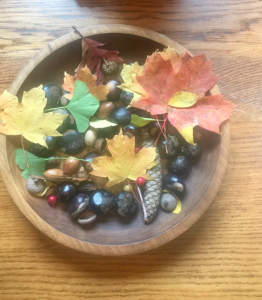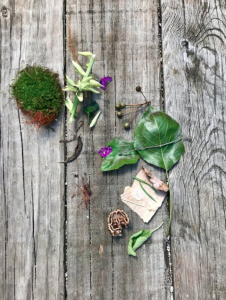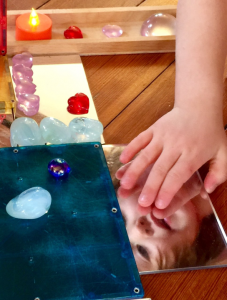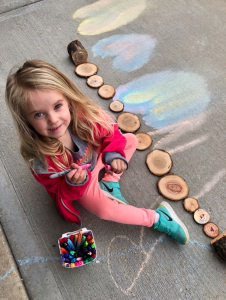Creating a Loose Parts Environment for Autumn and Winter Play

The term “loose parts” is all over the Internet and early childhood world these days and for good reason. I have witnessed firsthand how the learning changed when we brought in natural loose parts! Loose parts are so full of math opportunities and problem-solving and vocabulary-building opportunities. So, what exactly are loose parts?
Loose parts are natural or man-made materials, with no set of instructions, that can be used alone or with other materials. These open-ended materials can be moved, combined, stacked, taken apart and put back together, and most importantly repurposed. 
When we speak of loose parts, we are looking for materials that will spark imagination and creativity. Outdoor natural materials would include things like rocks, shells, feathers, grass, leaves, pinecones, pine needles, and seeds. Indoors, things like blocks, manipulatives, pouring devices like cups and funnels, buttons, play cars, people and animals, recycled materials like lids, boxes, paper tubes, envelopes; art supplies (popsicle sticks, buttons, beads, spools, etc.). The list is endless and you more than likely have these materials already or can find them and you won’t need to purchase a single thing.
September is a fabulous month for collecting materials for future loose parts play. We take nature walks almost daily and each child is equipped with a backpack for all their treasures that they collect along the way.  We often come home with buckeyes, acorns, dried berries, colored leaves, and who knows what else we may find! Loose parts that are collected by the child, spark beauty and joy in the eyes of the child. There are no directions on how to play with their newly found treasure, so this allows the child’s imagination to run wild! The child can use the acorn for soup, or an art project, or food for the stuffed animals.
We often come home with buckeyes, acorns, dried berries, colored leaves, and who knows what else we may find! Loose parts that are collected by the child, spark beauty and joy in the eyes of the child. There are no directions on how to play with their newly found treasure, so this allows the child’s imagination to run wild! The child can use the acorn for soup, or an art project, or food for the stuffed animals.
If nature isn’t your thing, take a hard look at where your children play. There is a good chance it will be filled with loose parts. If your child is into cars or ponies, start with that! Remove the toys that aren’t used or played with. They clutter the mind of the child and they can’t stay focused on what they are creating! Yes! I am giving you permission to remove the majority of the toys that cover your home! Less is more! The child’s creativity and focus will change, I promise you!
Many teachers and parents will rush out and get baskets and fill the whole room with rows and rows of loose part storage. A child walks in and dumps every single bucket, and walks away. Maybe they were looking for their one red car or green pony. Start small. Take baby steps with loose parts! Our friend and mentor, Bev Bos, always recommended change with the words, “Start in a corner!”  The reason is, we create chaos the minute we upend the whole room and bring in new supplies. So start small, start with what your child is playing with, and start where their interest lies. Did your mother or grandmother have a bottom drawer in the kitchen that was full of “toys” to keep you busy while they prepared meals? Chances are that drawer was full of cups and spoons, and random recycled loose parts!
The reason is, we create chaos the minute we upend the whole room and bring in new supplies. So start small, start with what your child is playing with, and start where their interest lies. Did your mother or grandmother have a bottom drawer in the kitchen that was full of “toys” to keep you busy while they prepared meals? Chances are that drawer was full of cups and spoons, and random recycled loose parts!
So how many loose parts do we need? I once read that we want enough loose parts so no one is left waiting, wanting, or wailing! Some experts recommend five play pieces for each child. So, if your classroom or child is very interested in dinosaurs, you need five for each child that gravitates to that area. If every single dinosaur is in play on most days, you will want to add more. Or add more elements that they are using with the dinosaurs. Build off the interest that they are focused on. Think outside of the box! Fabric is a great loose part that often finds its way into our block area for a river or lake, or to be added as clouds or a trail. Add shells or blocks or pieces of bark. When I witness a play buzz happening, I sometimes add supplies close enough to possibly be noticed to add to their play. Soon, this will not be necessary, but in the beginning stages of learning to play with loose parts, I think it adds to the creativity.
So where is the math? Mathematical concepts are created through their play with loose parts. You will begin to see deliberate patterns, sequences, and classifications by color, size, or type. Spatial recognition and intentionality of play will honestly have you shaking your head! I promise you, it is crazy! You will see sorting and separating, measuring, and logical classification. All of these are precursors for higher mathematical proficiency!
If you keep your materials available, loose parts outdoor play will continue into the winter months. If the forecast calls for snow, be sure to grab out all of the sand toys as these make great snow forms, and you can’t reach them if they are frozen in the sandbox! Building a snowman’s face uses loose parts! Make your life easy and pack a sack while the weather is warmer and put it in a safe place. (It took me a ridiculously long time to figure out this simple task!) We keep our aluminum bowls full of rocks, shells, and walnuts, and other loose parts ready for creative outdoor play. We use large “tree cookies” (See the picture below. This little girl is playing with “tree cookies”), or cookie sheets as a tray for each child to create their loose parts formations. This allows them to be picked up and moved and gives the child a frame for their work. We also need to acknowledge their work in process and it may need to stay in place for a day or two. They will know and you will know when the play is complete. I am often amazed at how quickly some creations come down and the oddness of things they want to leave up. There is a lot of time invested in these masterpieces and it is important that we treat this time and energy with respect. These masterpieces are math.  They are manipulatives and problem solving and intentional risk-taking at trying out new ideas. Take it slowly, but I beg you to try it. You will never look back. It is a hot topic these days for a very good reason! Let them play!
They are manipulatives and problem solving and intentional risk-taking at trying out new ideas. Take it slowly, but I beg you to try it. You will never look back. It is a hot topic these days for a very good reason! Let them play!
Awesome article! This explains what I’ve observed & experienced without understanding why. Love the encouragement to prepare in advance for winter, too! In comes the sand toys!
Thank you!
We will take a walk around our community looking for loose parts that we can use in our outdoor area.
MY kids love collecting things, especially outside. They are always eager to bring things inside to examine them.
I love the idea of putting fabric pieces in block area! I am thinking that this might encourage our little girls to enter into more block play. I think this will encourage me to look around for other loose items that might work well in block area. It seems that we too often equate block play with cars and animal figures and should be more creative.
Good Article
I like the idea of using nature to make patterns and it also helps with counting to and vocabulary
Love this! Great way to explore and investigate!
At the daycare we take nature walks and come back and build leaf people and animals with our natural loose parts. The children love to do this!